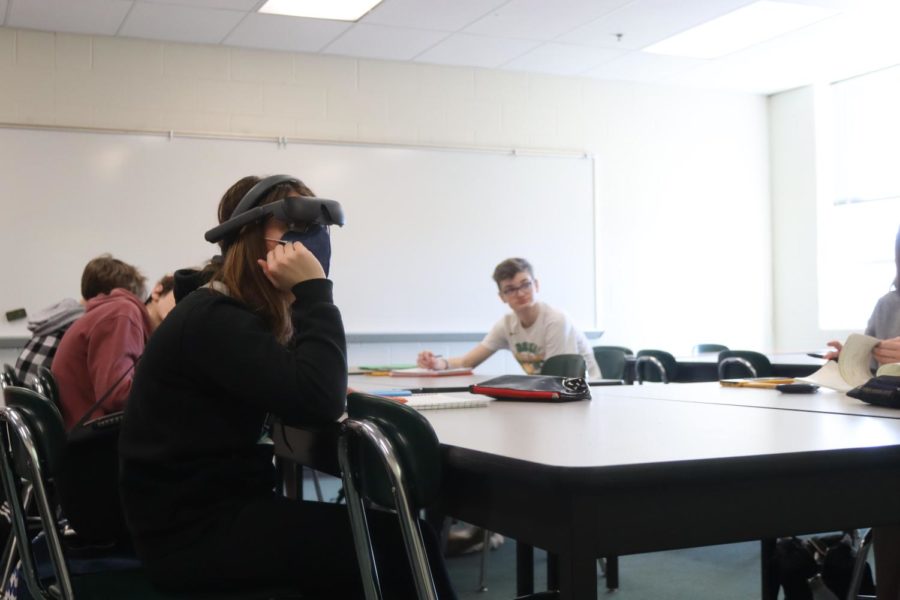In day-to-day life technology can be used to help with just about anything. Low vision technology for people with visual impairments has advanced tremendously over the years to the advantage of many people. For senior Camille O’Neil, the low vision technology she uses in the classroom has helped her become a visual learner despite her visual impairment.
O’Neill was diagnosed with Retinopathy of Prematurity as an infant. This eye disorder caused both of her retinas to detach. Her doctors were able to repair the retina in her left eye but not her right. Due to this and glaucoma, a group of eye conditions that damage the optic nerve, O’Neill’s right eye was removed when she was 3-years-old.
“I now have a prosthetic eye,” O’Neill said. “Right now, the vision in my left eye is like a sighted person looking through a paper towel tube, putting wax paper on it and dotting it with a Sharpie.”
When O’Neill began elementary school, her primary method of reading and writing was Braille. As she got older, O’Neill decided to become a visual learner. O’Neill worked with teacher of the visually impared, Cynthia McNair, to help find the best ways for her to learn. From third through seventh grade she used an Onyx flip camera that helped her to see both near and far in the classroom, but the flip camera was large and bulky and had to be wheeled from class to class. In eighth grade, O’Neill got her eSight glasses These smart glasses completely changed the way she functioned in the classroom.
“During middle school, her family purchased her first pair of eSights,” McNair said. “At that time, the technology was relatively new and cutting edge in the world of low vision devices. Since that time, the eSights have made improvements, and the technology is more powerful and more portable than ever before.”
The glasses provide the magnification that O’Neill needs to be able to see anything at a distance in her classes, like the teacher and the board, in a more portable way than the flip camera she previously used. ESights work using an auto-focus camera that projects a high-resolution image onto a screen in front of O’Neill’s eyes. The glasses also make it possible for her to read regular sized print up close that would otherwise be difficult.
“With my eSight glasses, I can now have a device on my head where I can switch between seeing the screen and seeing worksheets I may need to complete,” O’Neill said. “Also with my eSight glasses, I can now take pictures of the board and save them as notes so I can review them later. I can also do regular print worksheets instead of having things blown up.”
O’Neill’s parents and teacher for the visually imapired have seen how her eSights have helped her to grow as a visual learner and enjoy activities outside of school.
“The eSights have been a game-changer for Camille,” father Bill O’Neill said. “Whereas classroom materials previously needed to be enlarged or photocopied for her, she can now participate as her peers do. Outside of the classroom, the eSights have allowed her to more fully enjoy watching sporting events, both live and on television.”
With the help of technology O’Neill was able to grow as a visual learner and will continue to do so as she finishes her high school education.
This story was originally published on The Catalyst on March 16, 2022.



























![IN THE SPOTLIGHT: Junior Zalie Mann performs “I Love to Cry at Weddings,” an ensemble piece from the fall musical Sweet Charity, to prospective students during the Fine Arts Showcase on Wednesday, Nov. 8. The showcase is a compilation of performances and demonstrations from each fine arts strand offered at McCallum. This show is put on so that prospective students can see if they are interested in joining an academy or major.
Sweet Charity originally ran the weekends of Sept. 28 and Oct. 8, but made a comeback for the Fine Arts Showcase.
“[Being at the front in the spotlight] is my favorite part of the whole dance, so I was super happy to be on stage performing and smiling at the audience,” Mann said.
Mann performed in both the musical theatre performance and dance excerpt “Ethereal,” a contemporary piece choreographed by the new dance director Terrance Carson, in the showcase. With also being a dance ambassador, Mann got to talk about what MAC dance is, her experience and answer any questions the aspiring arts majors and their parents may have.
Caption by Maya Tackett.](https://bestofsno.com/wp-content/uploads/2024/02/53321803427_47cd17fe70_o-1-1200x800.jpg)
![SPREADING THE JOY: Sophomore Chim Becker poses with sophomores Cozbi Sims and Lou Davidson while manning a table at the Hispanic Heritage treat day during lunch of Sept 28. Becker is a part of the students of color alliance, who put together the activity to raise money for their club.
“It [the stand] was really fun because McCallum has a lot of latino kids,” Becker said. “And I think it was nice that I could share the stuff that I usually just have at home with people who have never tried it before.”
Becker recognizes the importance of celebrating Hispanic heritage at Mac.
“I think its important to celebrate,” Becker said. “Because our culture is awesome and super cool, and everybody should be able to learn about other cultures of the world.”
Caption by JoJo Barnard.](https://bestofsno.com/wp-content/uploads/2024/01/53221601352_4127a81c41_o-1200x675.jpg)






